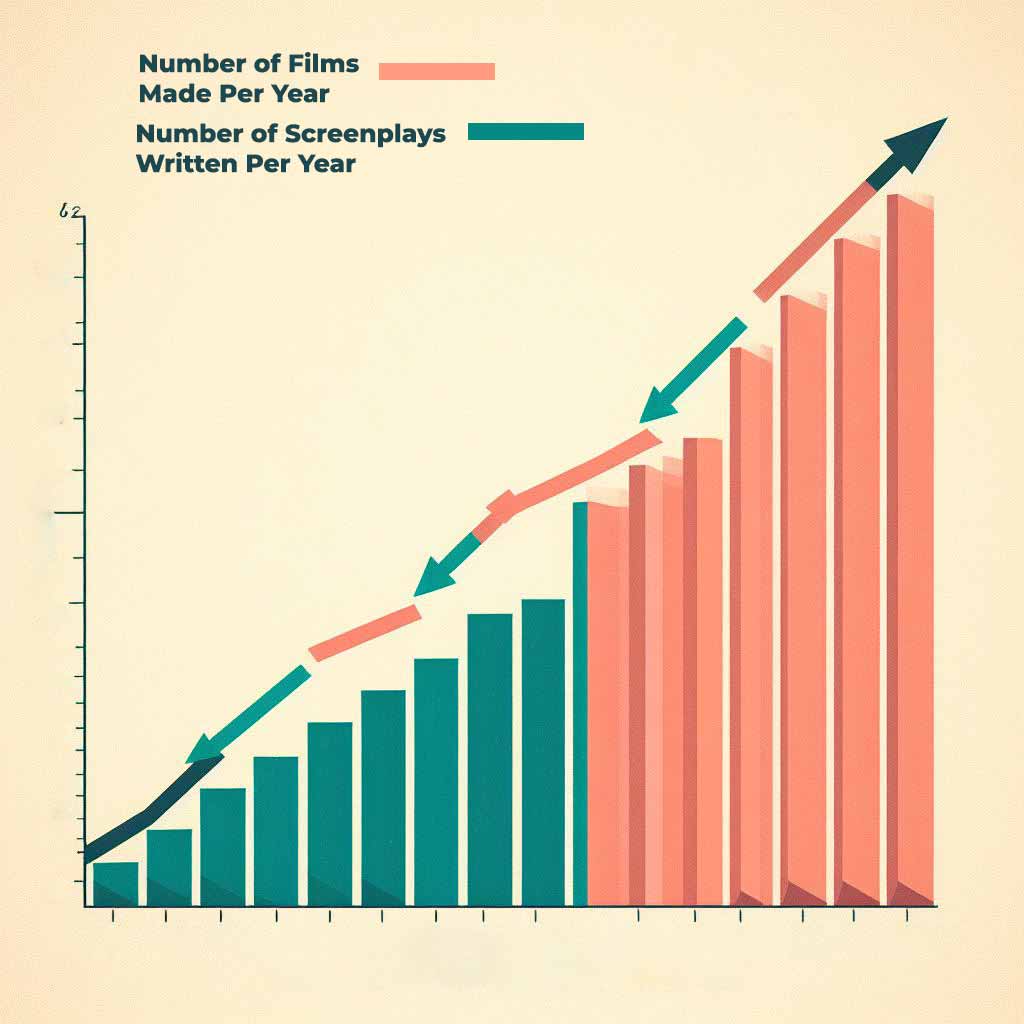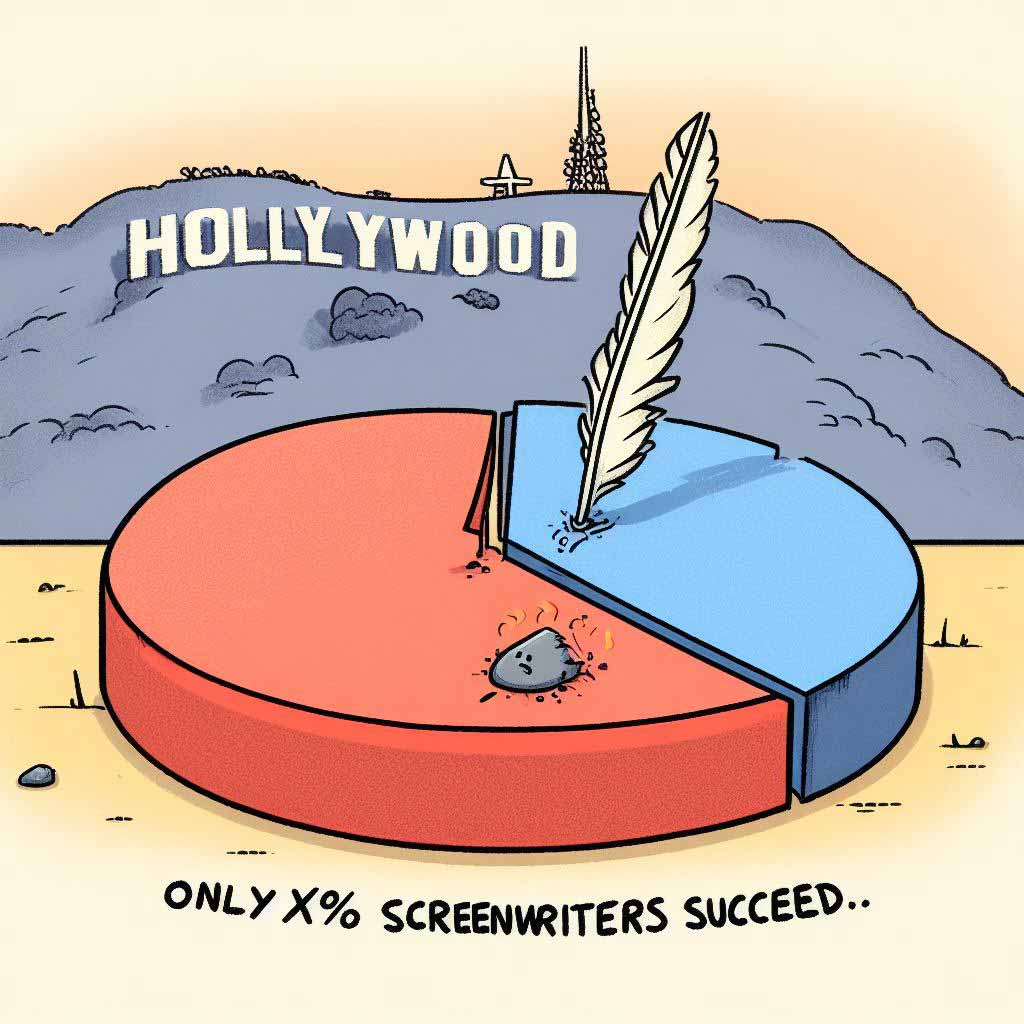We’ve all heard the lore – moving out to Hollywood, typing away at the next great American screenplay in a cramped studio apartment, and dreaming of one day seeing your name immortalized on the big screen.
It’s a tantalizing dream. But just how realistic is it?
Of the thousands of aspiring screenwriters who set out to make it in the ruthless Hollywood ecosystem, only a tiny fraction ever achieve financial success and critical acclaim. The odds are stacked heavily against the writer from the start.
Let’s dig into the surprising statistics and examine just how difficult it is to make it as a professional screenwriter in today’s landscape.

Defining Screenwriting “Success”
Before assessing the numbers, it’s important to define what “success” means for a Hollywood screenwriter. Potential metrics include:
- Getting a screenplay optioned or sold. This is the first level – simply getting paid for a script. But it doesn’t guarantee a produced film.
- Having a film made. Seeing your words turned into an actual produced movie that appears in theaters and on screens.
- Becoming a financially successful screenwriter. Make enough from screenwriting fees, royalties, etc. to support yourself.
- Achieving name recognition and critical acclaim. Getting known as a top screenwriter within the industry and winning major awards.

- Hitting it big with a major box-office blockbuster. The ultimate dream – writing the next megahit franchise film.
These definitions of “success” vary widely. Selling a single script doesn’t make you Sydney Lumet. Let’s look at the numbers at each tier.
The Long Odds Just to Get a Script Sold
In 2019, there were over 67,000 screenplays registered with the Writer’s Guild of America (WGA), the prominent screenwriter’s union. Yet during the same period, only 777 movies were theatrically released by major studios and production companies.
That’s nearly 90 scripts registered for every 1 movie produced. And getting to that coveted produced status is even more competitive.
Less than 5% of registered scripts will ever get optioned, sold, or produced according to industry estimates. The rest linger in obscurity in their authors’ desk drawers. But even selling just one script is extremely difficult.

Why are the odds so daunting? For starters, there is far more supply of scripts than demand from buyers. The film industry is hits-driven, where studios and producers seek out established, lower-risk projects. Scripts from unknown writers are passed over.
Development and production are also expensive. Unless a script is near-guaranteed to attract talent and audiences, turning it into a film is seen as too financially risky.
Getting past gatekeepers – agents, producers, development execs – as an unproven writer is also a massive challenge. It’s very much an inside “who you know” business.
Without serious connections, coming in as an outsider trying to sell a spec script that will cost millions to produce is almost impossible. Those aspiring writers typing away in obscurity face staggeringly high barriers.
The Few Working Professionals
If selling even one script is difficult, becoming a working, produced screenwriter in Hollywood seems like a pipe dream.
To assess this tier of “success”, let’s examine statistics on screenwriters who achieve WGA membership. The WGA is relatively exclusive, accepting only produced and established writers.
In 2022, the WGA West had over 10,000 members. But here’s the sobering fact – only around 1-2% were able to make a full-time living solely from screenwriting fees and sales.
The typical WGA member makes only about $5,000 – $10,000 a year from screenwriting. Most cannot support themselves and hold other jobs in film, TV, teaching, or beyond.

And WGA membership already represents the top fraction of aspiring screenwriters – over two-thirds of WGA members have earned over $100,000 in their careers from writing. Yet even at this high level, steady work and financial security are uncommon.
Why is consistent employment so elusive? Screenwriters rarely hold long-term contracted roles like TV staff writers. Work is project to project.
Even esteemed writers face extended periods between jobs or work for months on a script that doesn’t sell. And in film, writing fees are almost always flat, regardless of box office success.
Additionally, studios have moved from having a roster of go-to writers to tapping new up-and-comers more frequently. Even for professionals, it’s a constant hustle.
The Allure of Breaking In
Within the WGA, around 15% of members are considered “top tier” – consistently working writers earning over $200,000-$300,000 annually from screenwriting alone. This bracket represents the pinnacle.
Reaching this top bracket is the aspiration that keeps hopeful writers soldiering on despite terrible odds. And there are just enough success stories to fuel the dream.
Take Michael Arndt, who spent five years toiling away on unproduced scripts until he wrote Little Miss Sunshine on spec. The indie sensation got him a $250,000 sale and a career in Hollywood.
Or Diablo Cody, whose personal blog got her a book deal, leading to writing critical breakout Juno – and an Academy Award.
But for every Arndt or Cody, there are thousands of talented writers who never manage to cross that elusive line into professional success. Why?
Beyond just raw talent, making it requires remarkable persistence, dedication, strong business skills, and – perhaps above all – an ability to create the perfect commercially appealing project.
The Blockbuster Brass Ring
At the very top tier lies the superstar Hollywood multi-millionaires – the handful of writers like Steven Spielberg, James Cameron, David Koepp, and Melissa Mathison who create the major blockbuster franchises.
Their A-list status grants them the freedom to pick passion projects, receive first-look studio deals, and earn tens of millions for high-concept scripts.

But examining this peak reveals just how narrow the very summit is.
To illustrate, among the top 25 highest-grossing films of all time at the U.S. box office, only five original screenplays not based on existing IP appear – and these represent once-in-a-generation lightning strikes like Titanic, E.T., and Avatar.
Franchises overwhelmingly dominate the blockbuster scene. As a new writer trying to break into this uppermost echelon with fresh, original ideas – the realm where careers are immortalized – odds are infinitesimally tiny. The peak is crowded by only a handful.
Has the Landscape Shifted?
While the statistics paint a daunting picture, are there signs the terrain may be shifting just a bit for screenwriters? Increased opportunities from streaming platforms like Netflix and Amazon are opening new access points.
Web series and low-budget independent films also allow more avenues to get original scripts produced. Though financial rewards remain modest, these outlets are letting more diverse voices break through.
It Still Starts With The Script
But at the end of the day, selling scripts and getting made still revolves around writing something so fresh, compelling, and commercially appealing that gatekeepers take interest.
The fundamentals haven’t changed. For every writer who manages to cross that threshold, thousands more will not. The odds will remain astronomically stacked against the average hopeful.
But just maybe, if that script is so undeniably great that it starts a bidding war, catches studio executive’s eyes, and ignites a career – the dream can become reality. Unlikely, yes, but possible.

For the passionate and persistent with dedication to the craft and art of filmmaking, the long path of rejection may just lead to that life-changing moment. That hope is what keeps Hollywood’s aspiring writers endlessly typing, dreaming, and pushing for success.
The next great cinematic story might just be tapped out on a keyboard right now by an undiscovered writer yearning to have their vision seen. Will the odds defeat them? Or can they defy expectations and achieve that rarest of statuses – calling themselves a successful Hollywood screenwriter?
Frequently Asked Questions
What are the chances of being a successful screenwriter?
The chances are very small. Industry estimates suggest only around 1-2% of aspiring screenwriters are able to make a full-time living from writing scripts. Selling even one screenplay is very difficult with less than 5% of registered scripts getting produced.
Is there a high demand for screenwriters?
No, the demand in Hollywood for produced scripts and screenwriters is actually quite low compared to the number of writers trying to break in. Thousands of scripts are written each year compared to only a few hundred films that get made. The market is highly saturated.
Is it hard to get a job as a screenwriter?
Yes, it is extremely competitive and difficult to get hired as a screenwriter, especially if you do not have previous credits, connections in Hollywood, or a strong sample that gets attention. Most working screenwriters cannot support themselves on writing income alone.
What percent of screenplays get made?
Less than 5% of completed scripts end up getting optioned, sold, or produced into a movie. The vast majority languish unmade. Selling a script is only the first major hurdle to see it actually hit the screen.
What age do most screenwriters start?
Most successful screenwriters don’t break into the industry until their 30s or 40s. Writing skills take time to develop and doors rarely open until writers have strong samples and perseverance paying dues. Very few find instant early success.
How realistic is it to become a screenwriter?
It is not very realistic for most aspiring screenwriters. The odds of having a career solely from writing films are exceedingly slim due to huge competition and barriers. Success requires tremendous talent, persistence, and business savvy.
Why do most screenwriters fail?
Common reasons for failing to break in include lack of strong connections, producing poor quality scripts, not living in L.A., focusing on overly niche ideas, and inability to withstand constant rejection. Breaking through the system as an unknown writer is extremely difficult.
How do screenwriters get noticed?
Winning prominent screenwriting contests, getting scripts on annual “best-unproduced scripts” lists, finding managers/agents to advocate for your work, building a strong online presence, and networking relentlessly in the industry can help get noticed.
What screenplays sell the most?
Mainstream, high-concept scripts with franchise potential or built-in audiences sell for the most money. For example, action, superhero, sci-fi, horror, and some comedy scripts tend to be in the highest demand from studios and producers.


